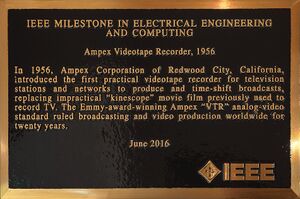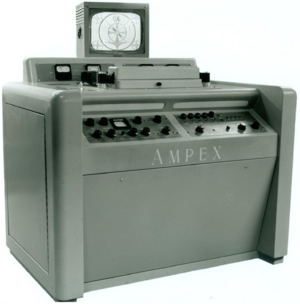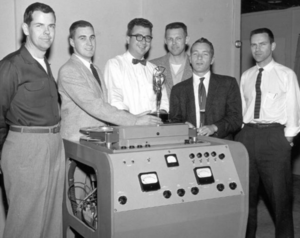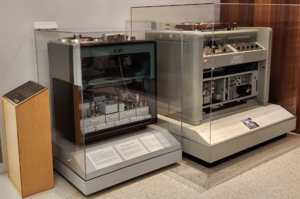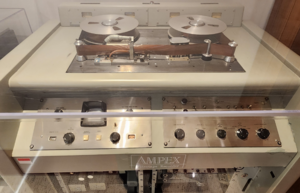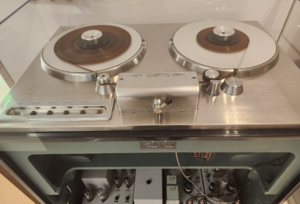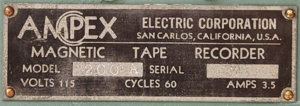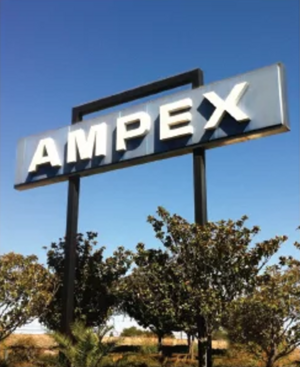Milestones:Ampex Videotape Recorder, 1956
- Date Dedicated
- 2016/06/10
- Dedication #
- 165
- Location
- Redwood City, CA
- IEEE Regions
- 6
- IEEE sections
- Santa Clara Valley
- Achievement date range
- 1956
Title
Ampex Videotape Recorder, 1956
Citation
In 1956, Ampex Corporation of Redwood City, California, introduced the first practical videotape recorder for television stations and networks to produce and time-shift broadcasts, replacing impractical "kinescope" movie film previously used to record TV. The Emmy-award-winning Ampex "VTR" analog-video standard ruled broadcasting and video production worldwide for twenty years.
Street address(es) and GPS coordinates of the Milestone Plaque Sites
Stanford University's Cardinal Hall, 505 Broadway, Redwood City, CA 94063 USA, 37.48505, -122.20427
- Note 1: The Milestone dedication venue and original site for the plaque and historic hardware was the Green Library on Stanford's main Palo Alto campus
- Note 2: Cardinal Hall is across the street from 500 Broadway, the 1954-2005 site of Ampex's headquarters. Ampex was founded in 1944 in San Carlos, CA.
Details of the physical location of the plaque
The plaque is directly behind the security guard's station in the ground floor lobby. The plaque is next to an original Ampex VRX-1000 videotape recorder and an original Ampex 200A Magnetic Tape Recorder (for audio recording). These two artifacts are part of the Ampex Collection as managed by the Stanford University Libraries. Further information is in The Ampex Story.
How the plaque site is protected/secured
Cardinal Hall is open 7am-5pm on weekdays, and access is controlled by a security guard. Visitors may ask to see the plaque and the two historic Ampex devices.
Historical significance of the work
Ever since the advent of public television there has been a need to record TV programs. Archiving, delayed transmission to accommodate time zones and editing are some of the reasons for this desire. At the beginning of public television in the middle of the 1940s until 1956 the only means available for the recording of TV was film (movie film). For accommodating transcontinental time zones in the United States it was necessary to record a program for the Eastern Time zone and replay the program at the appropriate time for each time zone across the country. (The same method was used in other countries around the world.) Fortunately, the industry was able to install a transmission line across the country which made it possible to send live programs with pickoff points along the way in various time zones.
The method used was to pick the undelayed televised program off the transmission line and display it on a TV monitor while pointing a movie camera at that monitor, thus making a film record of the program. Next, the film was rushed to a film-developing lab for rapid development and returned to the TV station where the film would be edited and at the appropriate time projected into a TV camera and that video signal broadcast into the surrounding area for local TV sets to receive. Some time zones might have only one hour to record, develop and transmit a program whereas other zones might have three hours for that process.
The negative aspects of this whole scheme were many. To start with, film was very expensive and, of course, it could only be used once. However, it was easy to archive for future needs. Another major drawback was the quality was very poor. For higher quality, 35 mm film was used but for most programs used16mm film. Sometimes a recording was made of a live performance and the developed film mailed to the station that was going to broadcast it. This made for better quality (especially when color broadcasting became available), however, again, this was very expensive.
Several companies worked on the process of trying to record TV onto magnetic recording tape. Some of these companies in the USA were RCA, General Electric, Minnesota Mining and Manufacturing Co. and Crosby Enterprises. In Europe several companies including Bausch Gmbh and BASF were working on the process. Baird TV and BBC in England spent large amounts of money in this pursuit.
In 1951 Ampex Corp., in the United States, started a video recording project which had little enthusiasm from management but was to be a buffer by developing some experience in TV. When one of the other major companies developed the process Ampex would already have some knowledge in television recording. After about a year of development the project was put on the shelf in favor of a project in sound recording for theaters. The project was revived in September 1954 and five engineers and one machinist produced a beautiful TV recorder, which was shown at an NARTB (National Association of Radio and Television Engineers) convention in Chicago on April 24, 1956. The first production recorder was completed and put into service late in 1956. The format used became the standard throughout the world for the next twenty years.
The VRX-1000 set off a storm when it was demonstrated on April 14, 1956 at the National Association of Radio and Television Broadcasters Convention, sending RCA and all the other VTR developers back to the drawing boards. The VRX-1000 was renamed the Mark IV and sold briskly at $50,000. Ampex dominated the broadcast VTR business for a number of years to come.
Obstacles that needed to be overcome
It is easy to understand why it is difficult to record television on magnetic tape compared to recording sound on the same medium. Normally it is considered that the range of frequencies in human audio sound is twenty to twenty thousand cycles per second (Hertz). The frequencies one might find in television signals that are to be recorded using a modulated carrier frequency (either AM or FM) are about one thousand times greater.
The range of wavelengths on the magnetic recording tape of an audio recorder (when running at 15 inches per second) would be 15/20 = .75 inch to 15/20,000 = .00075 inch. Reading such a wavelength with a playback head gap of .00025 would be no problem. The recorded wavelength on recording tape running at 15 inches per second and while recording 20,000,000 cycles per second would be 15/20,000,000 = .00000075 inch. A playback head gap of about one third this dimension (0.25 uinch) would have essentially no output. The logical solution would be to run the tape at a higher speed. To obtain the same short wavelength as was indicated above for the highest audio frequency the tape would have to run at 15,000 inches per second. Of course this is not logical. Even running at 1500 inches per second (125 ft./sec.) would be difficult to do. (A 5000 foot real of tape would last 40 seconds.)
Companies (other than Ampex) were trying this high-speed tape method and even multi-track configurations using frequency division multiplexing were used (from two-track to 10-track). Each of these companies were able to get some degree of success but none came even close to an acceptable picture for television broadcast.
Ampex chose to use a multi-transducer (4 heads on a 2-inch diameter drum) rotating at 240 revolutions per second (providing 1500 inches per second writing speed) to produce a picture within broadcast specifications.
Features that set this work apart from similar achievements
The Ampex Videotape Recorder was the first successful video recorder to be exhibited and to reach the market place. Other companies marketed videotape recorders in subsequent years; these were produced both legally under Ampex license, as well as illegally.
Significant references
Bill Slatkin, "The Ampex Contribution to US Diplomatic History", 29 November 2016
Ampex VRX-1000 20th Anniversary with Ray Dolby and Ampex Engineers at NAB 1976
Stewart Wolpin, "The Race to Video", Invention & Technology, Fall 1994.
"TV Goes to Tape", Popular Science, Feb. 1960, p. 238.
Ed Reitan, RCA-NBC Firsts in Color Television (commented)
"Charles P. Ginsburg", Memorial Tributes: National Academy of Engineering, Vol. 7, 1994, The National Academies Press, Washington DC.
Albert Abramson, “The History of Television 1942 to 2000” (http://books.google.com/books/about/The_history_of_television_1942_to_2000.html)
Videotape Recorder (VTR), U.S. patent number 2,956,114
Fred Pfost, First Hand History, "Recollections of Ampex and the Video Recorder" (Draft, unpublished, IEEE GHN)
John Leslie and Ross Snyder, "History of the Early Days of Ampex Corporation", AES Historical Committee, 2010 December 17, http://www.aes.org/aeshc/docs/company.histories/ampex/leslie_snyder_early-days-of-ampex.pdf
Quadruplex Videotape, https://en.wikipedia.org/wiki/Quadruplex_videotape
Charles P. Ginsburg, "The Birth of Video Recording", at http://www.labguysworld.com/VTR_BirthOf.htm
Ampex, Factbook 1970, http://www.aes.org/aeshc/docs/company.histories/ampex/ampex-factbook-1970.pdf
Dedication ceremony
On Display: Ampex VRX-1000
The following is on informational cards by the VRX-1000 that is on display.
The Birth of Videotape: The Problem
In the early 1950s, the only way to record television programs for later rebroadcast was with kinescope, which was basically a film camera aimed at a television screen. However, broadcasts from film were inferior to live television, and they were also extremely expensive to produce. By 1954, more raw film was being used by television broadcasters than by the entire movie industry.
Clearly, the ability to record television pictures on magnetic tape would be a boon to broadcasters. Recording video, however, is far more difficult than audio. Even a black-and-white television picture requires much more tape capacity than is required for an audio signal.
The key to recording video on tape was running more tape past the recording head per unit of time. One approach was to increase tape speed dramatically and recording longitudinally along the tape like audio. However, early experiments suffered from poor quality and ran through tape so fast that the process proved impractical.
The Birth of Videotape: The Solution
A dedicated team of engineers at Ampex, headed by Charles Ginsberg and including Charles Anderson, Ray Dolby, Alex Maxey, Fred Pfost, and Shelby Henderson, created the world's first practical videotape system. They made it possible to record up to one hour of broadcast quality audio and video on a manageable reel of two-inch wide tape. Broadcasters were so eager for a videotape system that they literally stood up and cheered at the first Ampex demonstration in 1956.
One vital development was the use of a rapidly rotating set of four recording heads that scanned across the tape rather than along it, making it possible first to record black-and-white images and later color. The first on-air use was November 30, 1956, when CBS rebroadcast Douglas Edwards and the News via tape on the West Coast three hours after it had originated in New York.
This particular Ampex VRX-1000 is the fourth one that was built. It was used for that first historic broadcast at CBS Television City in Hollywood, where it continued to serve faithfully for 20 years.
On Display: Ampex 200A
The following is on informational cards by the 200A that is on display. The German Magnetophon led to the creation of the 200A.
Ampex Model 200A, Serial No. 3
The Model 200A was Ampex's first postwar product, and was the first professional tape recorder to go into regular broadcast service in America. This machine was installed in ABC's radio network facility in Chicago, Illinois, on April 25, 1948.
Bing Crosby purchased 20 of the machines, including this one, and advanced the funds for the product production run. In gratitude, Ampex gave serial numbers 1 and 2 to Jack Mullin of Crosby Enterprises for his indispensable help in developing the 200A.
An impressive reliability record
ABC installed twelve of the model 200A machines in their Chicago facility for time shifting radio programs for the East Coast and the West Coast. They were operated as much as 18 hours per day. After a year, ABC had experienced a total of only three minutes of downtime. This extremely high reliability record convinced a skeptical radio industry that magnetic tape recording was the best answer to sound recording for broadcasting, and Ampex's success and reputation as a manufacturer of rugged and reliable machines was assured.
Within a year, many phonograph disc recording studios also converted to magnetic tape, where long playing time and ease of editing with scissors and splicing tape afforded by tape became essential to production of then-new LP vinyl records.
Specifications
Tape Speed: 30 inches per second during recording and playback. The 14-inch platter of tape plays for 32 minutes.
Frequency Response: uniform within 1 dB from 50 to 15,000 Hz.
Signal-to-Noise Ratio (SNR): over 60 dB with less than 1% harmonic distortion.
Restoration
Jack Mullin restored this machine in about 1980. It was placed in warehouse storage when the Ampex Magnetic Recording Museum was closed. It was again restored to full operational condition in 2011 and 2012 by Larry Miller.
Supporting materials
While not formally a proposer, we'd like to thank Fred Pfost for preparing the historical information and context above.
Notes for why the plaque text is worded as it is:
The bodycopy is 69 words.
I added the word "practical" to the VTR's description, something I always did at the Ampex Museum of Magnetic Recording when describing this technology. As early as 1956, RCA, with their "television recorder", and Bing at Crosby Video, had firm plans to commercially offer their longitudinal-scan machines; either one would have been eagerly embraced by an industry desperate to end film-based kinescope recording. Either Crosby's and RCA's longitudinal scan technology would have been better than kinescopes, but both were still fundamentally impractical, with their huge reels and high tape speeds gobbling up tape stock.
The mention of the Emmy means a lot to many Americans, especially good on a public plaque like this. Even techies and some academics love show biz! I hope the plaque maker can reproduce the "registered" ® symbol for "Emmy". It's copyrighted and NARAS is picky about this. We don't want to have to recast this plaque! But have no fear: with the simple ® symbol [or (R), if the plaque guy can't cope], no one needs their permission and can freely use the name "Emmy®". s I changed the headline to "Videotape Recording" from "Videotape Recorder". The point here is the breakthrough technology, not that particular machine.
Like many American companies using "Corporation" in their formal names, it's always simply "Ampex Corporation" never "the Ampex Corporation". Typically, organizations using the word "Company" do tend to add the definite article, as in "The Selznick Company".
Especially on a generalist plaque, the day and month are not important. The year is.
The street address is also unimportant, unless you're erecting the plaque at 934 Charter (where you might just say, "At this location"), instead of at Stanford. Anyway, before Charlie Anderson, Alex Maxey, and Fred Pfost joined the team, Charlie Ginsburg, Ray Dolby, and Shelby Henderson did some very important, early R&D work at 820 Charter!
The word "videotape" is an adjective, while "video tape" is the recording medium.
